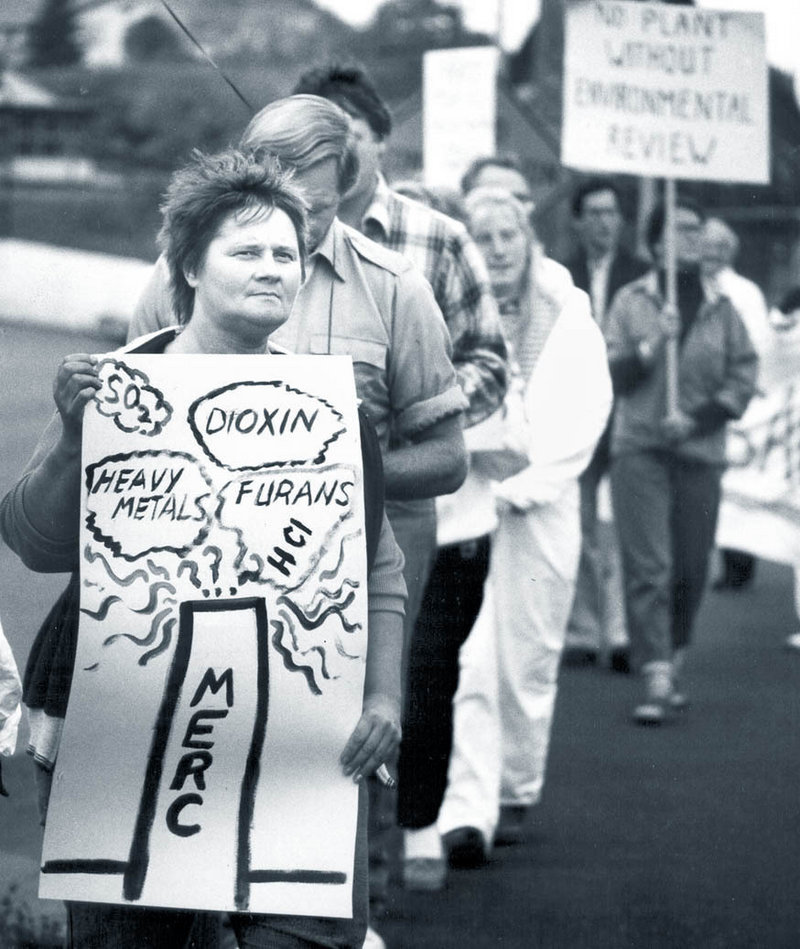A quarter-century has passed since the first truckloads of trash were dumped on the tipping floor of the Maine Energy Recovery Co.’s waste-to-energy incinerator in downtown Biddeford.
The decision to build a major waste disposal plant on Lincoln Street made sense in 1982, when officials in Biddeford and neighboring Saco first proposed the idea.
Both cities, and much of southern Maine, were wrestling with ways to close leaking landfills. And mill yards that once hummed with textile and shoe production were all but abandoned, making the site ripe for industrial development.
Welcome, too, was the tax revenue, which contributed $800,000 last year to Biddeford, the 80 or so jobs, and the electricity generation capable of powering 20,000 homes.
But almost immediately, the $105 million project became an unpopular neighbor to residents and businesses. In 1988, after only a year of operation, the state cited the plant for spewing toxic ash from its towering stack, and people were complaining about noise and odor. A state-ordered, $2 million retrofit followed.
In 1990, the two cities sued MERC and the incinerator’s designer, General Electric, claiming it had failed to build a safe and efficient plant. The cities won a $5.1 million settlement. A year later, MERC won an $11.5 million settlement with GE over the incinerator’s flaws.
Calls for the plant’s shutdown followed, with negotiations in 2004 between the cities and the owner, Vermont-based Casella Waste Systems Inc. A proposal ultimately emerged for Biddeford and Saco to buy the plant and close it, but in 2005 voters rejected a plan for each city to borrow $10 million for the task.
A majority of voters felt the cost was too high, but MERC’s ability to endure goes beyond money.
Its plant is one of four waste-to-energy plants built in the 1980s to handle Maine’s trash. The four facilities processed 856,941 tons in 2010, which was 35 percent of Maine’s trash.
The plant in Biddeford took in 284,718 tons of that waste stream. That means any proposal to close it is complicated by questions of how and where to redirect all that trash, and at what cost.
A shutdown appeared more likely in 2009, when Gov. John Baldacci’s office helped set up a task force that brought together officials from the state, both cities and the company.
A plan emerged to truck trash to a proposed processing plant in Westbrook that could produce fuel pellets to be burned in Biddeford. The clean power could help provide low-cost energy for the nearby mill buildings, which by then were experiencing a rebirth as homes and small businesses.
That effort fell apart amid infighting by the parties in 2010, and a federal grant to help pay for the processing facility didn’t materialize.
The latest push to close the plant features some fresh ideas, but faces the familiar obstacle of finding a practical and cost-effective place to dispose of the trash that’s created every day by more than three dozen communities.
The plan calls for a solid-waste transfer station in Westbrook and a new curbside recycling program in Biddeford. One part that’s sure to be controversial is the proposed sale of the state-owned Juniper Ridge Landfill in Old Town, which won Department of Environmental approval in January for an expansion but is opposed by some residents of the area. The sale will need to win legislative approval in the waning days of the session.
As the last quarter-century has shown, proposing alternatives to Biddeford’s unpopular incinerator is easy, but turning them into reality is not.
Staff Writer Tux Turkel can be contacted at 791-6462 or at:
tturkel@pressherald.com
Send questions/comments to the editors.




Success. Please wait for the page to reload. If the page does not reload within 5 seconds, please refresh the page.
Enter your email and password to access comments.
Hi, to comment on stories you must . This profile is in addition to your subscription and website login.
Already have a commenting profile? .
Invalid username/password.
Please check your email to confirm and complete your registration.
Only subscribers are eligible to post comments. Please subscribe or login first for digital access. Here’s why.
Use the form below to reset your password. When you've submitted your account email, we will send an email with a reset code.